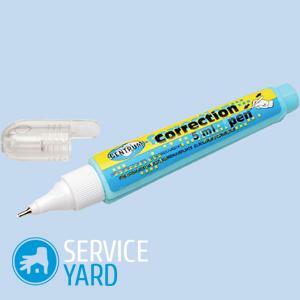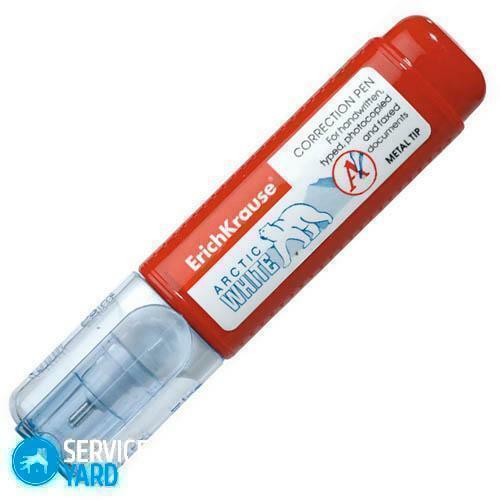
- The whole truth about the
- corrector. Varieties of proofreaders
- Than to dilute the dried out corrector?
Stationery products are very popular among schoolchildren, students, office staff, teachers and other people who very often have to work with papers and documentation. Modern technologies have made it possible to create a tool that will make the work as easy as possible and help you to correct unnoticed errors - the corrector. But the white liquid has the property of withering over time, and then we ask ourselves how to dilute the corrector to maximize its life. In this article we will show you the most effective ways how to achieve the desired result.
to the contents ↑The whole truth about the
corrector Despite the popularity of this stationery, today there is no universal composition of the corrective fluid. It is a kind of corporate secret of each specific manufacturer.
However, in each of the compositions in different proportions, the following chemicals are present:
- calcium carbonate;
- titanium dioxide;
- high grade gasoline.
But the most important component is exactly the corrector, which is known to almost every person interested in this issue, because it is indicated directly on the label of this office supply.
Liquid types of proof-readers can be divided into the following categories: water-based
- ;
- with alcohol component;
- based on emulsion.
To make a decision than to dilute the corrector of a stroke, it follows, starting from the basis of the substance contained in it.

Water Corrector
Corrective water-based formulations are environmentally friendly and the most safe for the human body, and therefore enjoy the greatest popularity among schoolchildren. The main advantage of this tool is a good application of the substance to virtually any type of paper.
However, as with any product, the water-based stroke has its drawbacks - a long drying time. The substance deposited on paper can dry for about a minute, which is quite inconvenient when writing.
Important! Also it is worth remembering that such proofreaders do not tolerate low temperatures, and therefore, when storing them, you should avoid hypothermia.
Spirituous barcode corrector
Alcohol-correcting compounds are more practical to use than their water-based analogues - due to almost instant drying. In addition, such products are characterized by increased resistance to freezing.
However, an alcohol-based barcoder has a sharp and slightly unpleasant smell, the substance easily ignites, and accordingly - is dangerous.
Oil-based corrector
The emulsion compound combines all the advantages of an alcoholic and water-based base. Such a corrector has no sharp odor, does not ignite, dries quickly and is absolutely resistant to low temperatures.
However, the cost of such office supplies is an order of magnitude higher than that of alcohol or water analogues. Yes, and find a similar tool is difficult.
to the contents ↑Variants of the correctors
Depending on the type of masking layer that is applied to the paper surface, the correctors can be divided into dry and liquid ones. Each of these categories has its own characteristics.
Liquid Correctors
There are two main types of stationery of this type:
- Correction fluids. Such chemical compositions are sold in small-volume bottles and are applied to the surface of a paper sheet with a blot with a brush, an applicator or a special sponge. Such products are quite convenient and easy to use, however in the modern office they are very rare, as manufacturers make a big accent on the release of more practical products.
- Corrector-pencil. In form resembles a conventional handle with a metal tip, through which the corrective fluid flows out. With the help of such a tool, it is possible to pinpoint even the smallest textual details.
Dry editors
This type of stationery is represented by a corrective tape-roller. This dry composition is characterized by operational efficiency and the ability to continue writing immediately after masking the existing blots. The width of the adhesive tape in dry correctors is usually 4-6 mm.
Important! Dry proofreaders are quite inconvenient in case of correction on paper with a small line spacing and a small font.
to the contents ↑Than to dilute the dried out corrector?
The question of how to dilute the finishing paste is quite popular and the solution of this issue depends, first of all, on the base used in the production. To dilute the dye, you may need the following liquid substances:
- water;
- alcohol or vodka;
- specialized compositions for dissolving the corrector;
- acetone;
- nail polish remover.
Important! When the dried composition is brought into operation, the main thing is not to overdo it with dilution. Otherwise, you risk getting a white liquid that will not completely paint over the blots on the sheet of paper, and accordingly it will become useless.
So:
- Water-based correctors do not cause any problems at all and are easily diluted with ordinary tap water.
- To restore the efficiency of the funds on an alcohol basis, any means that contains alcohol is suitable. However, it is best to choose the most pure alcohol-containing formulations without flavoring and coloring agents. After all, excessive impurities can adversely affect the quality of the corrector.
We hope that the tips provided in the article will help you to choose the most suitable way how to dilute the stroke, and the mistakes made in the texts will be easily and imperceptibly corrected.
